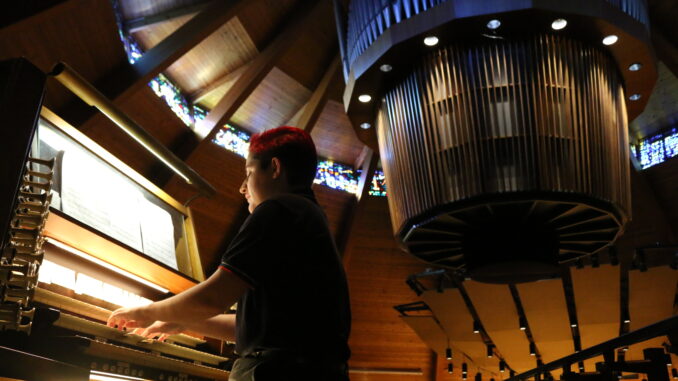
Did you know that Lewis & Clark is home to a world-famous pipe organ? The instrument attached to the Agnes Flanagan chapel is the world’s only circular pipe organ. It has been covered by national news and brings in celebrity organ players for recitals every year.
At the beginning of the 2022-23 academic year, the school discovered that the motor inside of the suspended portion of the organ, which receives signals from the keyboard and opens and closes the pipes to create sound, was broken. While unconfirmed, Grace Wenzel ’23, one of two organ students, speculates that this damage may have been a result of the roof construction during the summer prior.
The organ’s repair, originally scheduled for winter break, was postponed until January, and then again until spring break because of the heavy snowstorm. Now, with only a few weeks left in the year, it is back in full working order, just in time to play in the Orchestra and Choirs’ combined end-of-year concert on April 21, lending its dulcet tones to create drama and ambiance in Faure’s Requiem, an epic seven-movement religious piece full of tension and evocative layered polyphony.
Organ student Wenzel said he is thrilled to finally be able to utilize the instrument’s full capacities after nearly two semesters of lessons playing on a truncated portion of the instrument. Wenzel explained that he had been practicing with only the choral division, a small section of pipes situated behind the keyboards meant to imitate the sound of choir vocals, which is the only part not suspended and so left unaffected by the motor failure.
“I am extremely excited that it’s now back in commission and that people can hear it at the orchestra concert, and will continue to hear it in the future,” Wenzel said.
Wenzel, who grew up listening to organ music and feels a connection to the instrument, decided to take lessons his senior year to fill some of the free space in his schedule after completing most of the required courses for his music major. He is one of only two organ students at LC, alongside Helen Traczyk ’23. While Wenzel has over a decade of piano experience and knowledge of music theory and harmony which have helped, he said that there were also many new and complicated aspects to organ playing which made the instrument intimidating at first.
“It’s very involved,” Wenzel said. “Whenever you’re choosing sounds, you have all of these controls. It’s all of these moving parts to keep track of, so it’s very difficult when you start, but as you start to learn and be able to find your way around the instrument, it becomes less of a giant puzzle and more of a palette and you can do all sorts of things with all of these tools that are at your disposal.”
Wenzel has come to love the complex nature of the organ with its many abilities and parts. The organ is composed of three keyboards, a row of pedals and two panels filled with different stops that imitate sounds of other instruments and produce various effects. Each keyboard controls a different part of the organ, meaning pipes of different sizes and materials produce different levels, qualities and pitches of sounds. The keyboards can be coupled, achieving the effect of playing multiple parts of the organ simultaneously, and many different stops can be combined to create variable nuanced sounds.
“It’s part of the building, and when you’re there at the console it feels really powerful,” Wenzel said. “You’re controlling all of this wind and all of this noise and it’s an awesome instrument in the true sense of the word and it can be fearsome.”
This particular organ exists because it was an answer to a singular problem. After construction of the Agnes Flanagan Chapel in 1968, the school wanted to complete the project with the installation of an organ. The chapel’s unique architecture, however, with its 16 walls creating the effect of a circular interior, meant that a regular pipe organ wouldn’t fit well in the space. LC recruited organ builder Larry Phelps to design an organ tailored to the shape and acoustics of the chapel.
Phelps rose to the challenge, suspending a wooden cylinder from the center of the chapel’s high, peaked ceiling. Rows of pipes, which would traditionally sit in a row and project sound outwards into the audience, instead wrap around the cylinder and create sound waves which bounce off of the chapel’s ceiling, walls and floor, creating a warm cloud of sound which surrounds listeners and seems to weave itself into the very air between the stone floor and rows of pews. Wenzel said that playing this instrument feels particularly significant due to its scale and power.
“I’m also a vocalist and that kind of music-making is very intimate, very internal, very connected, but with the organ it feels very external and powerful,” Wenzel said.
In September, LC will host Daryl Robinson, director of organ studies at the University of Houston to perform a free recital for students. If you are interested, make sure to come hear this one-of-a-kind instrument’s full range of sound fill the chapel next fall.
Subscribe to the Mossy Log Newsletter
Stay up to date with the goings-on at Lewis & Clark! Get the top stories or your favorite section delivered to your inbox whenever we release a new issue.

Leave a Reply